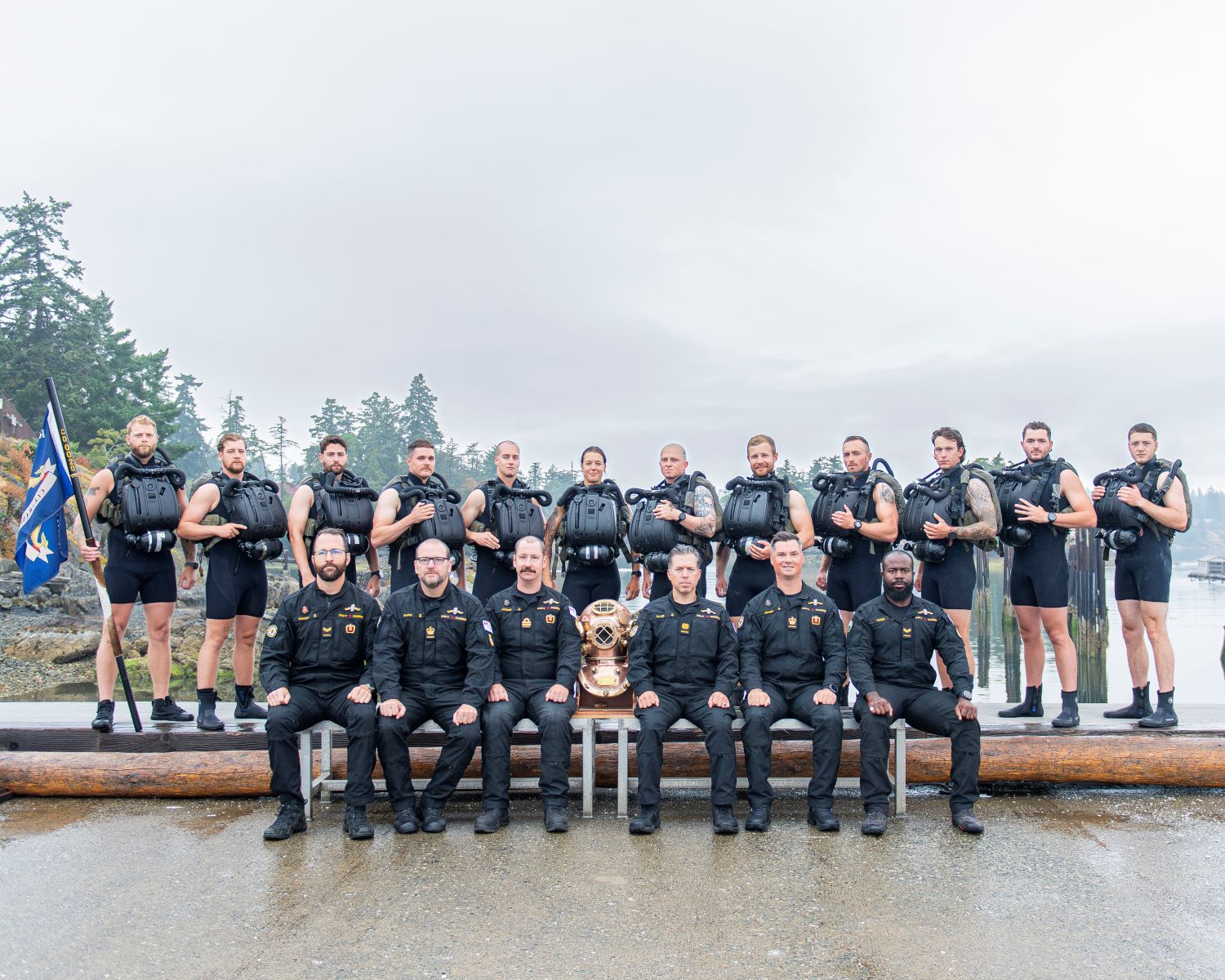Hard Work and Heavy Seas: RCN Welcomes New Clearance Divers
October 27, 2025 - Royal Canadian Navy
By Lt (Navy) Michael Cormie, Fleet Diving Unit (Pacific)

Caption
The graduating Clearance Diver class with the course staff.

Caption
Two Clearance Diver students in Surface Supplied Breathing Apparatus enter the water at the start of a dive to a depth of 90 meters.
After 13 months of training above and beneath the ocean waves, 12 new clearance divers are surfacing with pride.
On October 10, at Fleet Diving Unit (Pacific) (FDU(P)), 12 students from the 2025 Clearance Diver Qualification Level 1 (QL1) course will officially graduate, marking a major milestone in their Royal Canadian Navy (RCN) careers. Each graduate receives the Clearance Diver Dolphin pin, symbolizing their achievement and readiness to serve.
Among the graduating class is Sailor Third Class (S3) Thomas Fournier, who joined the RCN through the 2023 Naval Experience Program (NEP). Originally from Muskoka, Ontario, S3 Fournier successfully challenged the Clearance Diver Assessment Centre (CDAC) in February 2024.
“My experience on the clearance diver course was the best year of my life,” said S3 Fournier. “There were lots of opportunities for self-development, professional growth, and team cohesion. Everyone I worked with was helpful and supportive. I’ve developed in many ways and I’m ready to add wherever I go as a clearance diver.”
Clearance Divers are the Canadian Armed Forces’ (CAF) deep-sea mine disposal specialists. They operate a range of diving equipment, including the Compressed Air Breathing Apparatus (CABA), rebreathers, and Surface-Supplied Breathing Apparatus (SSBA). Their work extends both underwater and on land, where they have supported missions in Afghanistan helping to neutralize improvised explosive devices (IEDs). Clearance Divers also support Health Services with recompression treatments and submarine search and rescue (SUBSAR), as well as maintain diving equipment for all CAF diving teams, including Search and Rescue Technicians and combat divers.
Some of the new Clearance Divers will begin their careers at the School of Diving, training the next generation of CAF divers. Others will support underwater repairs and maintenance for His Majesty’s Canadian ships and take part in salvage and mine countermeasure operations.
Clearance divers are also trained in advanced conventional munitions disposal, fulfilling the CAF domestic explosive ordnance disposal mandate. This often requires divers, frequently those holding the rank of Sailor First Class, to deploy across British Columbia to recover and safely dispose of unexploded military ordnance.
S3 Fournier is prepared to deploy on various operations and exercises, including Operation REASSURANCE in the Baltic or Black Sea, Operation RENDER SAFE in the Pacific, or Operation HORIZON alongside Canada’s Indo-Pacific allies.
“We’re always looking for fit, smart, and motivated people to become Clearance Divers,” said Lieutenant (Navy) Michael Cormie, FDU(P). “We’re in a period of reconstitution, where we are focused on increasing the number of Clearance Divers available to support CAF operations. I encourage people to apply for what’s arguably one of the best jobs in the Navy.”
Voluntary Occupation Transfer (VOT) to the Clearance Diver trade is open to all non-commissioned members (NCMs) from all trades, with or without previous diving experience. Recent changes now allow officers, Regular or Reserve, from any trade to challenge the Clearance Diver Assessment Centre (CDAC) to become Clearance Diving Officers (CLDOs).
The Clearance Diver Assessment Centre takes place each February. While this year’s Regular Force deadline has passed, Reservists can still apply until October 31. Extensions may be available depending on individual circumstances. For more information, visit the FDU(P) SharePoint site under the School of Diving section or contact the School of Diving at ESQFDUTRG@intern.mil.ca.